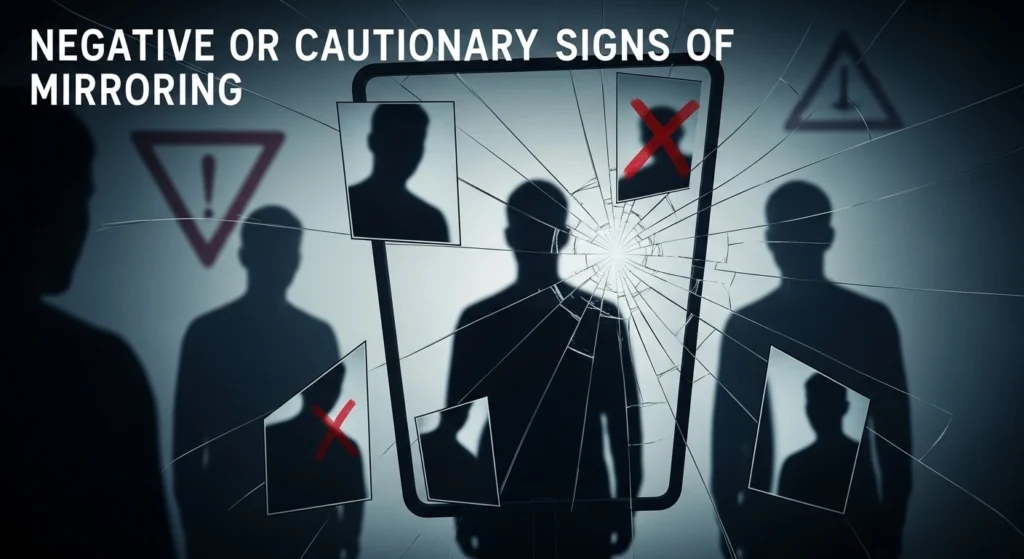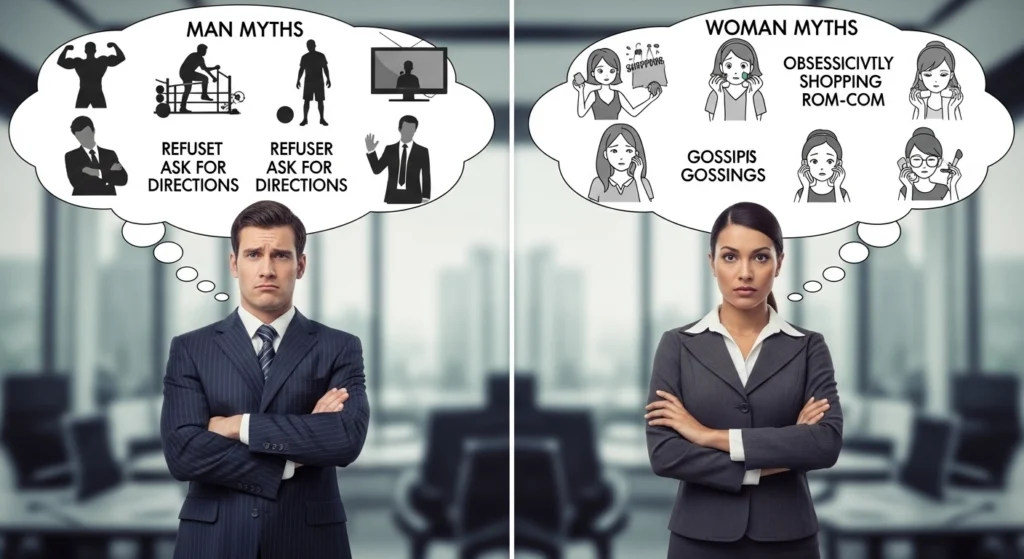Mirroring in psychology means copying another person’s actions, words, or body language without even thinking about it. It’s a natural part of nonverbal communication and happens in many social situations. For example, if a friend smiles, you might smile back without planning to. This is part of mirroring behavior psychology, where people often reflect each other’s tone, posture, or gestures during conversation.
You can see mirroring in everyday life more than you realize. When two people are talking and both lean in, use similar hand movements, or match their speaking pace, that’s mirroring at work. I’ve often noticed in meetings that when I cross my arms, the person I’m talking to might do the same within minutes. It’s not about copying on purpose—it’s about a natural connection that builds trust and understanding.
Psychologists sometimes call this the “chameleon effect.” It’s when people mimic each other’s behavior without noticing, much like a chameleon changes colors to match its surroundings. This can happen in friendships, work conversations, or even between strangers. Research shows that mirroring can help people feel more connected and comfortable with each other, making it an important part of how humans bond and communicate.

Positive Reasons a Man Might Mirror a Woman
Attraction and Romantic Interest
One of the most common reasons a man mirrors a woman is attraction. This can show up as him matching her body language, using similar words, or even laughing in the same way. These are often unconscious signs of liking. I remember noticing this once during a coffee date — every time I leaned in, he leaned in too, and it made the moment feel more connected. Mirroring in attraction works because it creates a natural sense of being on the same wavelength, which can make romantic chemistry stronger.
Building Rapport and Comfort
Mirroring can also help build rapport and a feeling of comfort between two people. When someone matches your posture or speaking pace, it sends a silent signal that says, “I understand you.” This is why mirroring for connection is often taught in communication skills training. I’ve used this in work meetings without realizing it, and it made people more open and cooperative. Feeling “in sync” can turn a casual chat into a warm, trusting conversation.
Empathy and Understanding
Sometimes mirroring comes from empathy rather than attraction. When a man listens closely and subtly mirrors a woman’s gestures or tone, it can mean he’s tuned into her emotions. This kind of emotional attunement makes the other person feel heard and validated. I’ve found that when someone mirrors me while I’m sharing a personal story, it feels like they truly get what I’m saying. It’s a small, nonverbal way to build emotional safety in a conversation.
Subconscious Mimicry
In many cases, mirroring is completely subconscious. People often copy others without realizing it, thanks to our brain’s mirror neurons. This is known as subconscious mimicry, and it’s different from deliberate mirroring that some use to persuade or charm. Genuine mirroring feels natural and flows with the conversation, while forced mirroring can seem awkward or even fake. Most of the time, when a man mirrors a woman, it’s simply his brain’s way of connecting in the moment.
Negative or Cautionary Signs of Mirroring

Overly Obvious or Forced Mirroring
Sometimes mirroring can go from natural to uncomfortable. If someone copies every move, word, or habit you have, it can feel fake. This kind of copying stands out because it doesn’t match the normal flow of a talk. I once met someone at an event who repeated almost everything I said — same tone, same words. Instead of feeling close, I felt like I was being watched. When mirroring is too forced, it loses warmth and can start to feel “creepy.”
Lack of Self-Identity
Another warning sign is when mirroring takes over a person’s own personality. In relationships, constant copying can mean someone is unsure of themselves or afraid to be different. There’s a big difference between being inspired by someone and fully imitating them. I’ve seen friends change their style, hobbies, and even opinions just to match a partner. Healthy relationships allow each person to be themselves.
Mirroring as a Manipulation Tactic
Sometimes, mirroring is used to manipulate. People with controlling or narcissistic traits may mirror to win trust fast, then use it for their own gain. It can feel like “identity theft” in relationships, where the other person copies your likes, values, and habits to seem like your “perfect match.” I’ve spoken with people who felt flattered at first, but later saw it was just a trick to pull them in. In psychology, this is a red flag because it’s about control, not real connection.
The Role of Context in Understanding Mirroring
Dating vs. Friendship Context
Mirroring can mean different things depending on the type of relationship. In dating, it’s often a sign of flirtation or attraction. A man might copy how you sit, your smile, or your gestures to feel closer to you. In friendships, mirroring can simply show comfort and connection without romantic feelings. I’ve noticed that when a close friend mirrors me, it feels natural and easy, but in dating, it can create a spark.
Cultural and Personality Differences
Culture can change how people use mirroring. In some places, close body language is common, while in others, personal space is important. Personality also plays a role — extroverts may mirror more openly, while introverts might do it in subtle ways. I once worked with an international team and noticed that some members mirrored as a way to build trust, while others avoided it because it felt too forward in their culture.
Situational Triggers
Mirroring often happens more when emotions are strong. In a relaxed setting, like chatting over coffee, mirroring can feel warm and friendly. In high-stress moments, such as during an important meeting or argument, people may mirror without realizing it as a way to connect or calm tension. I’ve even caught myself matching someone’s posture during a tough talk — it made the other person feel heard and understood.
The Chameleon Effect in Relationships

Origin of the Term “Chameleon Effect”
The term “chameleon effect” comes from a 1999 psychology study by Tanya Chartrand and John Bargh. They found that people often copy another person’s body language, voice tone, or small actions without even knowing it. This kind of copying, called mimicry, can help people feel closer. I first learned about it during my psychology training and realized I do it all the time — like tapping my foot when the person next to me does. It’s not about pretending to be someone else, but about naturally blending in with them.
Benefits of the Chameleon Effect
When it happens naturally, the chameleon effect can build trust and help people feel more connected. It makes conversations easier and helps others feel understood. In relationships, mirroring can create a strong emotional bond, like you’re “in tune” with each other. I remember a coffee date where both of us leaned in at the same time and laughed in the same way — it felt like we had known each other for years. That’s the magic of natural, genuine mirroring.
Risks of Over-Mirroring
Even though mirroring can be good, doing it too much can cause problems. Over-mirroring can make you lose your own personality or make someone think you’re not being real. Sometimes, it can even be mistaken for manipulation. I’ve worked with clients who felt worn out because they were always matching their partner’s actions, opinions, and style. Healthy mirroring should still leave room for you to be yourself.
How to Tell if Mirroring is Genuine
Natural vs. Forced Mirroring
One of the easiest ways to tell if mirroring is real is how natural it feels. True mirroring often happens without the other person even knowing it. Their timing matches yours, and their gestures or expressions are soft and natural, not overdone. Forced mirroring feels different — it’s often a little late or almost too perfect, like they’re trying hard to copy you. Real mirroring blends into the conversation and happens over time, not just in short moments. Look for patterns in body language, like posture, facial expressions, and hand movements all matching at the same time, instead of focusing on just one action.
Matching Emotional Energy
Real mirroring isn’t only about copying movements — it’s also about matching your emotional energy. When someone truly connects with you, their tone, speed, and mood naturally line up with yours. If you talk faster, they do too. If you relax, they relax. In my experience, when this happens, it doesn’t feel like they’re watching you — it feels like they understand you. This kind of mirroring is often a sign of interest or attraction. Notice if their voice, expressions, and overall vibe match the mood you’re setting. When it’s real, it feels easy and natural.
How to Respond When a Man Mirrors You
When a man mirrors you, it’s often his way of showing comfort and connection without words. This can look like matching your posture, hand movements, or even the way you speak. Many times, it happens without him even thinking about it. I’ve noticed in my own life that this kind of mirroring often feels natural and easy. Knowing how to respond can help you either grow the bond or keep clear boundaries, depending on how you feel.
If You’re Interested in Him
If you like him back, you can encourage the connection by mirroring him a little too. For example, if he leans forward while talking, you can lean forward slightly as well. Keeping steady eye contact and smiling warmly can make the moment feel more personal. I’ve found that laughing at his genuine jokes or giving a simple, honest compliment works well. These small actions show that you enjoy his company and want to connect.
If You’re Not Interested
If you don’t feel the same way, you can be kind while setting clear limits. One way is to keep your posture neutral and avoid matching his gestures too much. This can help prevent sending mixed signals. You can also guide the talk toward neutral topics or politely end the chat if needed. This way, you stay respectful but make it clear you don’t want a deeper connection.
Common Myths About Mirroring

Myth: Mirroring Always Means Attraction
Many people believe mirroring always means someone likes you in a romantic way. While that can be true, there are many other reasons it happens. People often mirror to build trust, show empathy, or connect during work conversations. I’ve seen clients mirror my posture or tone without even noticing, simply because we were in sync. According to research from the University of California, mirroring is a part of body language that makes people feel understood—not just desired. If someone copies how you sit or gestures like you do, it could just mean they feel comfortable, not that they’re flirting.
Mirroring also happens in friendships, teamwork, and public speaking. Think about talking with a close friend—before long, you might both lean in at the same time or sip your drinks together. That’s not romance; it’s connection. Teachers, leaders, and speakers often use mirroring on purpose to help people feel at ease. I’ve even used it in job interviews to create mutual respect, and it worked even when attraction wasn’t involved at all.
Myth: Only Men Mirror Women They Like
Some people think only men mirror women when they’re interested, but that’s not true. Women mirror men too, and people also mirror others of the same gender. It’s a natural part of human communication in all cultures and settings. I’ve seen women mirror male coworkers in meetings, not because of attraction, but to show they’re engaged. Friends, siblings, and even strangers at events can also mirror each other without realizing it.
This kind of mirroring—whether between men and women, or same-gender pairs—is well known in social psychology. A good example is team sports, where players often match each other’s body language to stay in sync. In my own group projects, I’ve noticed mirroring happens most when people are working toward the same goal. It’s more about creating a natural flow in conversation than about romance.
FAQs (Frequently Asked Questions)
Does mirroring mean he likes me?
From my own experience, mirroring often happens when someone feels a connection with you. If a man copies your body language, the way you speak, or even your expressions, it might mean he’s interested. Experts say mirroring is a natural way to build trust and comfort. But it’s not always about romance—it can happen in friendships or even at work. I’ve seen people mirror others simply because they respect or admire them.
Can mirroring happen without attraction?
Yes, it can. Mirroring is part of human behavior and helps people connect. I’ve mirrored my friends during conversations without having romantic feelings for them. In dating, it might show interest, but outside of that, it just means the person is paying attention. Studies from the American Psychological Association show that mirroring helps build rapport in any kind of relationship.
How do I know if mirroring is manipulative?
Trust your gut and look at the situation. If a man mirrors you but also makes you feel rushed, pressured, or uneasy, it could be a tactic to win your trust too quickly. I’ve met people who later realized someone mirrored them for the wrong reasons. Healthy mirroring feels natural and respectful. If it comes with dishonesty or pressure, take it as a warning sign.
Is mirroring a sign of true love?
Mirroring can be part of love, but it’s not enough on its own. True love is shown through care, respect, and support over time—not just body language. In my past relationships, mirroring often happened early on, but real love was proven in how we worked through challenges. It can make two people feel close, but lasting love is built on trust, shared values, and commitment.
Conclusion
When you understand mirroring behavior, you start to notice small but important details in how people act. In simple words, mirroring means copying another person’s body language, tone of voice, or even words without thinking about it. It can be a sign of comfort, trust, or sometimes attraction. From my own experience, when someone mirrors you—like crossing their arms when you do—it often means they feel connected to you. But you should look at the whole situation, not just one sign, before deciding what it means.
When reading mirroring behavior, remember it’s not always about romance—it can also mean respect or wanting to connect. The best way to understand it is to think about the context. For example, someone might mirror you in a job interview to show they agree or to make you feel comfortable. I’ve learned that matching someone’s pace, tone, or gestures can make conversations easier and warmer. If you want to know more, the American Psychological Association has research on body language that can help you improve your skills.
